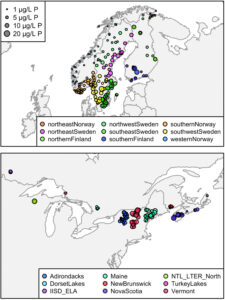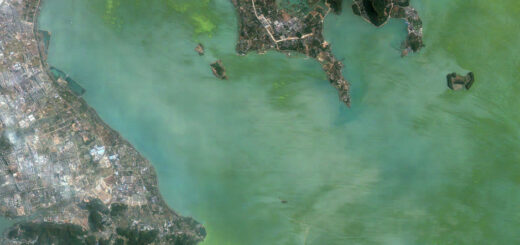Phosphorous is one of the most important nutrients involved in aquatic plant and plankton productivity. Exceptionally high phosphorous levels can lead to the over-activity of algae and other aquatic vegetation, which causes a ripple effect that impedes the system’s ability to cycle nutrients properly. At the same time, low phosphorous levels can negatively impact aquatic plants’ growth, leading to the loss of a foundational part of the food web. Phosphorous levels fluctuate across the world due to a variety of causes: land use, agriculture, urbanization, runoff events, nutrient loading, pollution, temperature variances, and many other environmental factors.

Map of sites showing regions (colors) and median Total Phosphorous concentrations for each lake in Fennoscandia (top) and North America (bottom). NTL_LTER_North denotes the north temperate lakes long-term ecological research lakes. IISD_ELA denotes the IISD Experimental Lakes are in Ontario (Credit: Isles et al., 2023 CC BY 4.0)
A 2023 study published in Limnology and Oceanography Letters combined data from almost 400 lakes in 18 regions in North America and Northern Europe in order to observe patterns of year-to-year variability in phosphorous and consider how large-scale climate factors impact total phosphorous concentrations. Previous studies have focused on understanding the interactions between climate and human land use, but this study sought to analyze and understand the direct impacts of climate factors on phosphorous concentrations in relatively undisturbed lakes.
Methods
The study used three different approaches to assess the direct influence of climate variables on lake phosphorous concentrations. These methods were used in compiling and analyzing nearly 400 lakes in order to assess shared climate influences, investigate synchrony among regions and compare seasonal total phosphorous shifts. Synchrony, defined as the mean pairwise correlation across a set of lakes, serves as an indicator that regional factors, rather than local factors, influence variability in ecosystem properties.
First, researchers investigated synchrony on annual median total phosphorous, hypothesizing that lake total phosphorous would be synchronous within regions since they share climate influences. Second, synchrony among regions was investigated to assess larger-scale climatic influences under the hypothesis that nearby regions would be more closely related than distant regions due to similarities in climate. Finally, a bootstrapped random forests analysis was used to compare total phosphorous to seasonal climate variables and determine which factors had the greatest impact. The random forest analysis also allowed regional median total phosphorous to be correlated to seasonal climate teleconnection indices and identify large-scale climate controls on total phosphorous concentrations.

Foggy lake near Sogndal, Norway (Credit: Moise Nicu via Flickr CC BY 2.0)
Results
Significant synchrony was found in lake total phosphorous both within and among different geographic regions. The bootstrapped random forest analysis revealed that winter temperature was the most important factor in controlling annual total phosphorous, followed by summer precipitation. The role of winter conditions is likely connected to varying under-ice productivity and snowpack on the frozen lake surface that influences system productivity. Overall, the results suggest that, in the absence of overriding factors like land use change, total phosphorous concentrations and lake productivity may decline with continued winter warming in northern lakes.
Sources
Isles, P.D.F., Creed, I.F., Hessen, D.O., Kortelainen, P., Paterson, M., Pomati, F., Rusak, J.A., Vuorenmaa, J. and Bergström, A.-K. (2023), Widespread synchrony in phosphorus concentrations in northern lakes linked to winter temperature and summer precipitation. Limnol. Oceanogr. Lett. https://doi.org/10.1002/lol2.10318







